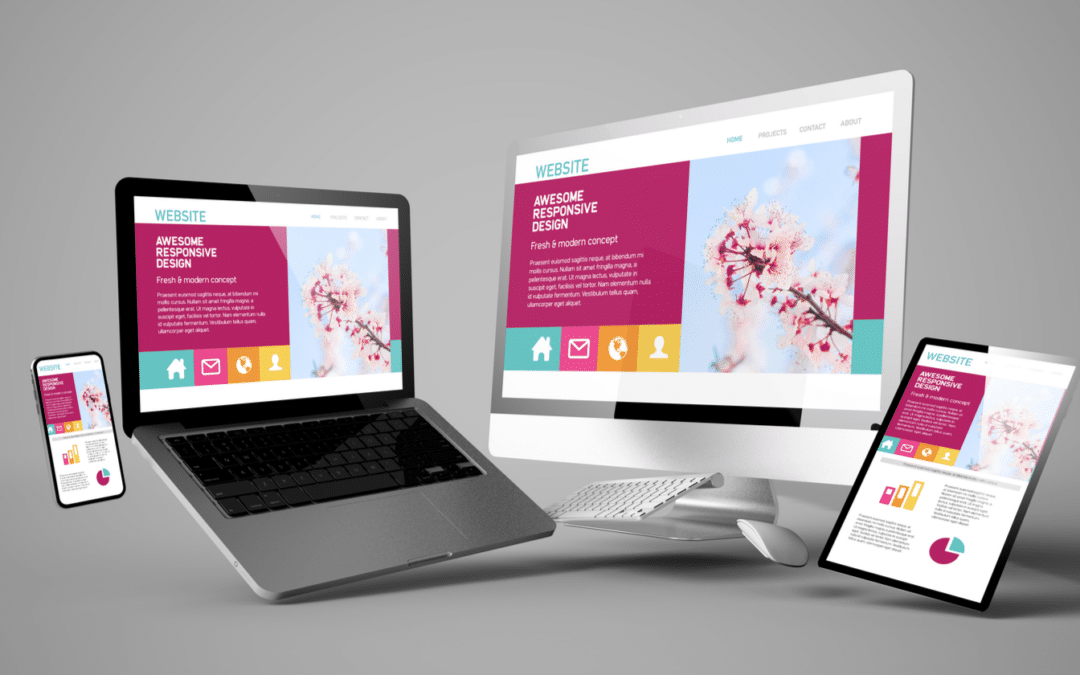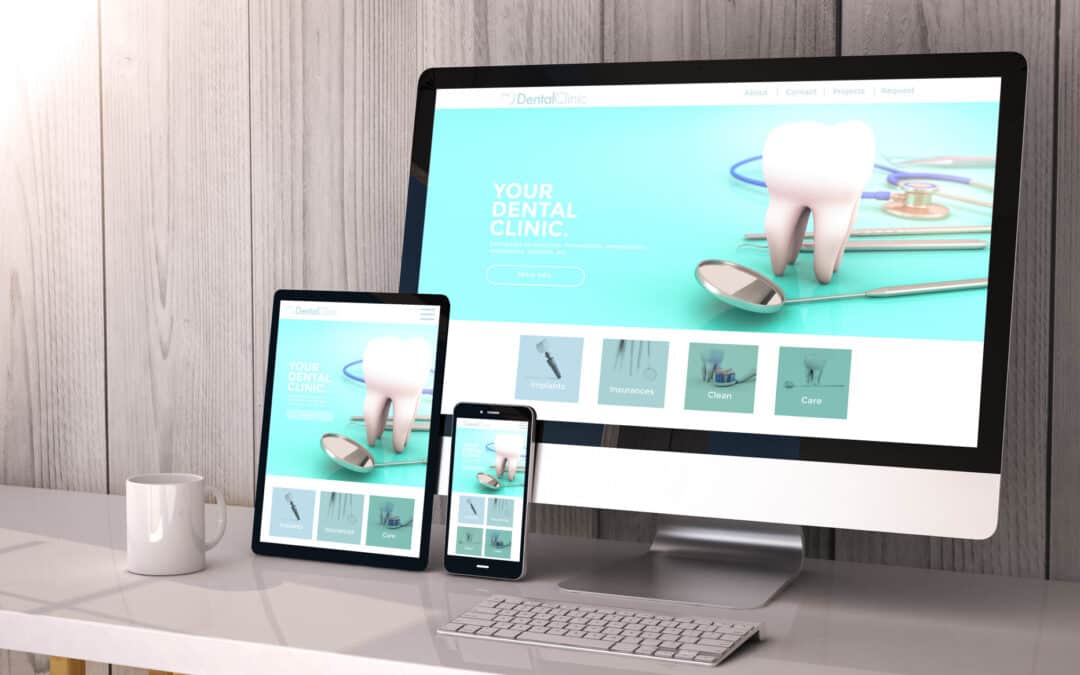
by Harris & Ward | Jul 24, 2023 | Web Design, Harris & Ward
In today’s digital age, having a strong online presence is crucial for the success of any business. A well-designed website serves as a virtual storefront, allowing potential customers to explore your products or services and learn more about your brand. If you’re ready to take your business online and create a website, this guide will walk you through the essential first steps to get started.
Establishing Your Goals For Your Website
Before diving into the website creation process, it’s essential to establish clear goals and objectives for your website. Ask yourself what you want to achieve with your online presence. Are you looking to generate leads, sell products directly, provide information, or establish your brand identity? Understanding your goals will help us shape the overall design and functionality of your website.
How Will You Structure & Design Your Website?
Organizing your website’s structure and navigation is also vital for user experience. Start by creating a sitemap that outlines the main sections and pages of your website. This may look different for everyone depending on your business. For example, a dental website sitemap could have pages that outline different treatment options, a staff page to meet the dentists, and a page with information on how to schedule an appointment. Different types of websites will have different pages and sections. It’s important to consider how you want your visitors to navigate through your content, ensuring it is intuitive and easy to follow. A well-structured website makes it effortless for users to find the information they are seeking.
The design of your website plays a significant role in attracting and retaining visitors. Create a visually appealing and user-friendly interface that aligns with your brand identity. Choose a color scheme, typography, and imagery that convey the right message and appeal to your target audience. Keep the design clean, consistent, and intuitive, ensuring effortless navigation and readability across devices.When meeting with clients to work on the design of a website, we start by asking if they already have a branding package. If the client only has a logo, we use their logo to pull colors and create a palette with 5-6 colors. Different colors evoke specific emotions and associations. For example, warm tones like red and orange can convey energy and passion, while cool blues and greens evoke a sense of calmness and tranquility. Understanding the psychological impact of colors helps in aligning the color scheme with the intended message and brand identity. Clients are given two options of color palettes to choose from to represent their brand.
Clients are also sent an on-boarding form when we start a project and this asks questions about the design and feel of the site. Some of the questions we ask clients are: Do you have any branding for your business? Will a logo revision be needed? Do you have any recent photography from the past 5 years? What is the primary goal of your website? Is there a design theme to your office or branding? Do you gravitate towards vibrant colors or neutral colors? Do you have a tagline? Are there any websites that you love? etc. These questions allow us to inform decisions for the design.
Fonts are usually determined by the feedback given on the on-boarding form. Mood boards can also be created to help get the look and feel clients are looking for nailed. A well-crafted mood board should evoke a specific mood or atmosphere. Consider the emotions you want your website visitors to experience. Do you aim for a vibrant and energetic vibe, or a calm and serene ambiance? Select images and colors that align with the desired emotional response.
Design styles are really important because different styles can portray the type of business you are and the message you are trying to convey to your customers. Some clients may want a website with a more professional feel versus others who may want a funky vibe. This can all be conveyed on a website through the color scheme, typography and branding. Design styles on websites act as a language, speaking to visitors and conveying messages beyond words. By carefully selecting a design style that aligns with your brand’s values, target audience, and intended message, you can create a visually compelling website that captivates users, communicates effectively, and leaves a lasting impression. Since this is so important, we work with clients to determine exactly what they are looking for during the on-boarding and design process.
Now It’s Time To Build Your Dream Website
After collecting this information about your design and layout, our production team will begin the wire-framing process. Wireframes serve as a skeletal representation of your website’s structure and layout. They focus on organizing content, determining page hierarchy, and mapping out navigation. Wireframes are typically created to allow you to visualize the website’s structure without getting distracted by visual design elements.
Once the wireframe is approved, we will proceed to the design phase, where we will work with developers to transform the wireframe into a visually appealing and interactive mockup. They will create a comprehensive representation of how your website will look and function. The mockup will showcase the website’s color scheme, typography, imagery, and other visual elements, allowing you to envision the final product. We also offer professional photography and videography for small businesses so your website can have pictures and videos that show off your company.
The mockup is not a final product but rather a starting point for collaborative feedback and refinement. Our team will share the mockup with you, seeking your input and suggestions. Your feedback is crucial in this stage as it ensures the design aligns with your expectations and preferences. Together, we will make necessary revisions and adjustments until it accurately represents your desired website design.
After multiple rounds of feedback and refinement, we will present the finalized mockup for your approval. Once you are satisfied with the design and functionality, we will build out your site with our content writers and web developers.
Prioritizing The User Experience On Your Website
Before launching your site, we will do testing to make sure everything is user-friendly and technically sound. In addition, our website hosting service offers routine maintenance checks to keep your site live and secure and make sure everything is working correctly. We monitor website performance, uptime, and speed, addressing any issues promptly. Regular backups and security checks are conducted to safeguard your website and protect it from potential threats. Additionally, we stay on top of software updates, ensuring that your website is running on the latest versions of content management systems, plugins, and other essential components.
After creating your website, our agency also performs search engine optimization (SEO) maintenance. We conduct keyword research, analyze website analytics, and optimize meta tags, headings, and content to ensure that your website is easily discoverable by search engines. By staying on top of algorithm changes and best practices, they help your website maintain a competitive edge in search rankings.
Looking For A Website To Match the Quality of Your Business?
Our company offers website design for a variety of clients including dentists, orthodontists, chiropractors, optometrists, financial advisors, and many more small businesses. Our team creates affordable websites and provides video and photography services to get your website started. If your business is seeking a new website, visit our website to get started!
Top 6 Elements of Great Web Design

by Todd Boak | Sep 5, 2022 | Web Design
Website Design Tips for Financial Advisors
As a professional, you know it pays to make a strong first impression. With more people searching online for the financial advice they need, sometimes, your website makes that impression for you.
An out-of-date website could tell potential clients your expertise is out-of-date, too.
38% of people will stop engaging with a site if the design isn’t appealing. With that in mind, here are nine website design tips to help you upgrade your website.
With these tips for financial advisors, you can make a strong first impression that helps you build your business.

1. Know Your Audience
Before you start making changes to your website, it helps to know who you’re making these changes for.
Determine your target audience. Are you looking for clients in specific industries? Once you know your niche, start researching.
What are their likes and dislikes? What financial problems are they facing that they require help with?
By answering these questions, you can update your design and content to reflect your clients’ needs.
As you continue reading these website design tips, keep your audience in mind. You can even research your competitors to determine what finance industry web design trends are working (and which flop).
For an extra website tip, make sure you’re offering your clients valuable content, too. This can include blog posts or white papers that reflect your clients’ distinct needs. By providing them this content, you can show your clients that you’re the helpful, informative resource they need.
2. Keep It Simple
As you start implementing these website design tips, make sure to keep it simple.
Don’t clutter your pages with large images or dizzying animations. Too much on a single page can overwhelm your site visitors. It can also slow down the page.
People don’t want to wait around for a page to load. A one-second delay can cause a 7% decrease in conversions.
Check for elements that are dragging your page speed.
Improving your website load time can also improve your search engine optimization. The faster your page loads, the likely you can get a higher ranking. The higher you rank on search engines, the more site traffic you can get.
If you need help using these website design tips, consider using a minimalist approach. The minimalist design will keep your site visitors focused on your content. Instead of distracting them with images, you can drive them towards a form.
That way, you can keep people on your website and direct them toward becoming a lead.
3. Add White Space
Once you have the essentials on the page, it’s essential to consider how to arrange them.
Even if you’re only using a few design elements, you can still end up cluttering the page. To make sure you give your design elements room to breathe, add white space.
White space makes it easier for people to read your website content.
Instead of overwhelming them with imagery, you can direct them toward a conversion opportunity. A cleaner design can also keep you from distracting site visitors.
That way, they stay focused on the reason they visited your website in the first place (to seek financial advice).
4. Make Sure It’s Mobile
The majority of people are checking sites from their mobile phones. If your website isn’t optimized for smaller screens, you’re missing out on potential customers.
Make sure your website is mobile-friendly.
Otherwise, people have to pinch and squint to read your content.
Mobile-friendly websites should also load quickly, too. If they’re forced to wait, your site visitors might leave and seek financial advisors elsewhere.
Google uses the mobile version of your website to determine your search ranking. By improving your mobile site, you can rank higher on search pages and in time, attract new customers to your business.
5. Get Engaging with Videos
Video content can give a face, name, and voice to your company. Video content on your landing pages can increase conversions by over 80%. More people are choosing to watch videos instead of skim-reading page copy.
The finance industry web design can benefit from videos, too.
Add a video above the fold of your website design. Make sure you engage people. Then, finish your video off with a strong CTA (more on this below).
6. Eye-Catching CTAs
Your CTA, or call-to-action, inspires site visitors to take action.
What do you want people to do once they’re on your website? Maybe you’d like them to fill out a form, call, or subscribe to your newsletter. Either way, make sure this action is clear.
Use your CTA in a headline, body text, or a CTA button.
Your button should stand out on the page. For example, if the page background is white, use a pop of color on your button to draw the eye.
7. Demonstrate Credibility
Why should people trust you for financial advice?
Show people, you’re a credible resource in your field by posting reviews from happy customers.
You can also feature case studies and statistics on your website to show interested clients you’re there to help.
8. Use High-Quality Imagery
Imagery can help set the mood on your website. For example, cartoons or blurry photos won’t make you look like a professional, credible company. Instead, use high-quality images to show your professionalism.
If you can’t find the right stock photography, higher a professional photographer. They can take images at your business to add professionalism and authenticity to your website design.
9. Know Your Value
As you’re using these website design tips, consider your firm’s value. What do you offer that no other financial advisor can?
Then, focus on this value within the design. In your page copy, make sure it’s clear that you have something to offer your clients. By focusing on this value, you can make sure you stand out from the crowd.
Otherwise, why should potential clients choose you?
A Fine Idea: 9 Website Design Tips for Financial Advisors
Your clients are looking for someone they can trust—so show them they can trust you. With these website design tips, you can upgrade your website and make a stronger first impression with your clients.
Ready to give your website an upgrade? Tell us your story today.

by harrisward | Jun 1, 2022 | Web Design
About 65% of businesses say generating website traffic is among their top marketing challenges. Without quality traffic, you’ll never generate leads or sales. Your entire digital marketing strategy could suffer as a result.
Before that happens, use these tips to start generating traffic to your dental website. With these digital marketing tips, you can help your dental practice grow.
As more people find your website, they can discover the benefits of choosing your dental services. Then, you can book more appointments, help more patients, and grow your practice!
Read on to generate traffic to your website today.
Understand Your Audience
Before using the rest of these digital marketing tips, take a moment to gather research. Researching your audience will help you determine the best way to attract them to your website. If your content doesn’t appeal to their needs, they won’t visit.
Consider who your customers are by gathering demographic and psychographic research. For example, you can create buyer personas based on:
- Pain points
- Buying behaviors
- Online behaviors
- Age
- Gender
- Location
- Salary
- Education
- Career
- Hobbies
- Interests
- Language
Focus on the pain points your customers are experiencing. Understanding their pain points can help you create content that aligns with their needs. You’ll have an easier time becoming a go-to resource for your customers if you offer them helpful solutions.
To strengthen your business marketing strategy, gather keyword research for each group. Keyword research can help you determine what questions your customers ask while online.
You can use these tools to develop a list of target keywords:
- Ahrefs
- SEMRush
- Answer the Public
- Google Trends
- Keyword Planner
Focus on long-tail keywords that include four or more words. These are more precise, allowing you to understand the consumer’s needs.
For example, it’s easier to understand “how to tell you have a cavity” over the short-tail keyword “cavity.” The latter could mean the consumer wants to know what causes a cavity or how to treat a cavity. A broad keyword will make it more difficult for you to write content your patients want to read.
Create Informative Content
Consider three topics you want to cover on your dental website’s blog. For example, you might cover oral hygiene, cosmetic dentistry, and orthodontic treatment.
Then, select three subtopics for each main topic. Under cosmetic dentistry, you might choose teeth whitening, veneers, and implant dentistry. Make sure to gather a list of target keywords for each subtopic you select.
Use your keyword research to inform your content marketing strategy. Select a target keyword from your list before writing your content. Otherwise, trying to add the keyword into the post after the fact can make it sound awkward.
When creating content for your dental website, make sure it’s engaging and informative. Helpful content can help you generate traffic. If your content doesn’t provide patients with value, they’ll leave.
As people leave your site, your bounce rate will increase, impacting your search engine rankings. As your rankings drop, potential patients might struggle to find you online.
Use SEO
Nearly 70% of all online activity begins on a search engine like Google. With search engine optimization (SEO), you can appear as patients search for a dental practice. Improving your rankings will help you generate traffic.
Make sure to optimize each page on your website with a target keyword. Your target keyword should appear in the:
- Page title
- URL
- Opening paragraph
- Body text
- Closing paragraph
- An H1 header
- SEO title and meta description
- Image file name and alt text
The SEO title and meta description will appear on search engine result pages (SERPs). Make sure they’re engaging and attractive to boost your clickthrough rate. Improving your clickthrough rate will help your rankings improve.
Go Local
As part of your SEO strategy, it’s important to consider local SEO. Start by optimizing your Google Business listing. Your listing can help patients find your location, phone number, and website.
They can click on the link to your site to explore your dental services.
Ask your patients to post their reviews on your listing as well. Positive reviews can boost your credibility, encouraging more people to explore your practice.
Generate Backlinks
Backlinks will send visitors on other websites to your dental website. You can generate backlinks by guest blogging. Otherwise, consider hiring a dental marketing agency that offers link-building services.
Generating backlinks will further improve your organic rankings.
Design Eye-Catching Ads
Pay-per-click (PPC) advertising will help you reach patients on social media, Google SERPs, and other websites. When someone clicks on your ads, they’ll reach a landing page on your site.
You can use your demographic and keyword research to ensure your ads appear in front of prospective patients.
Create both text and display ads. You can use display ads to generate brand awareness.
Start Using Social Media
You can reformat your blog posts for the social media platforms your patients frequent. Social media marketing can also help you boost engagement.
For example, you can host a live Q&A video session to answer questions and concerns your patients have about their dental hygiene. You can also use Story stickers to create polls, quizzes, and other forms of interactive content.
Add a link to your site to generate traffic to the full blog post.
Work With Influencers
Expand your reach on social media by working with an influencer. Influencers can promote your dental website to their existing audience.
Otherwise, consider posting user-generated content. Ask your patients to tag them in their photos when they talk about your dental services. Then, share their content to boost your brand visibility and credibility.
Analyze and Optimize
Analyze the results from your digital marketing campaigns to determine which strategies helped you generate the most traffic. Check Google Analytics to determine where consumers arrive from, too. For example, you can determine which visitors found you on SERPs or through social media.
Use your analytics to adjust and optimize your campaigns to generate more traffic in the future.
Brush Up: Start Generating Traffic to Your Dental Website Today
Developing a strong digital marketing strategy can help you generate traffic to your dental website. As you generate more traffic, you’ll have the chance to help new patients. Get started with these easy tips.
Otherwise, consider partnering with an experienced digital marketing agency. An agency can manage your campaigns while you help patients.
Eager to get started? We’re happy to help.
Harris & Ward has been selected among the Top AdWords Agencies by DesignRush. Contact us today!

by harrisward | Nov 29, 2021 | Dental Marketing, Google, Web Design
Did you know that 94% of the first impressions of your website are design-related?
A poorly designed website can lead to a negative user experience in which the user clicks off your page. Not only might they go to your competitors, but these potential customers now have a negative impression of your company.
So no matter how good your content is, you need to focus just as much on the elements of web design so your site is easy to use and is pleasing to the eye.
To help you, we’ve compiled the top 6 elements that every well-designed website should include. Keep reading to learn everything you need to know to create a website your customers will love.
1. Bold colors and images
Your color palette is a vital component of making sure your business materials are cohesive and on-brand.
Think about what primary and secondary colors you’d like to use on your website. Then, think about whether they represent your brand. You can use the principles of color psychology to help you.
You can also use what’s called a hero image on your main page. A hero image is located at the top of your main page and acts as an oversized banner.
The hero image should be high resolution, add value, and reflect your company’s unique selling point (USP). The hero image can also be a short video.
Since all of the images of your website should reflect your brand, it’s a good idea to take your own photos instead of relying on stock images.
2. Clean and Eye-catching Typography
While you may love that new elegant, handwritten font you found, this type of font isn’t the best option for use on your entire website.
Think about the title/logo fonts of social media sites like Instagram and Twitter. Not only is their font easy to read, but you’d recognize it as their brand even without the logo.
Good web design uses fonts that are easy to read, catch your viewer’s eye, and also help establish your brand identity.
Some best practices when choosing your font are:
- Black or gray typography
- Text larger than 16 pixels
- Enough space between the lines
- Fonts that are standard for the web
If you want to add a handwritten font to add a more personalized and friendly touch to your site, use it sparingly. Make sure it fits with your brand story and use it in places like captions or when emphasizing certain words.
3. Search Bar
You might think that a search bar isn’t necessary if your menus are well-organized, but it’s a vital part of good web design.
While a potential customer may not need the search bar if they have no problems finding your contact information, they might need it when looking for a specific product, blog post, or any older information.
You also want to reduce the number of clicks that users need to make to get the information they’re looking for. This reduces the chances that they’ll click off your website and go to a competitor’s website instead.
The best design for a search bar is that it’s easy to use and find on the page without interfering with your content. You can add a magnifying glass icon to make the search bar even easier to find.
4. Mobile-Friendly
Over 2 billion people use their smartphones to access the Internet, and this number is only expected to grow.
So if your website looks bad on mobile, is difficult to navigate, or doesn’t load at all, you can expect that your viewers will click off the page and go to your competitors instead.
Since creating a mobile-friendly website is very difficult if you’re not a web developer, you’ll want to get a web design SEO agency to help you.
Don’t forget to test site speed both on mobile and desktop, as a slow website will only make users click off the page and be unlikely to return.
5. Powerful Calls to Action
If you don’t have a call to action, you’re missing out on sales and making it difficult for website visitors to contact you.
A call to action (CTA) is text that prompts your website viewer, customer or lead to take action. A few examples of common CTAs include:
- Buy now!
- Subscribe to our newsletter for 15% off
- Learn more
- Contact us
To create the right CTA for your website, first determine the purpose of your site. Then, create an easy-to-see action button that would make sense for your website.
For example, if you’re an e-commerce store, include a button for customers to sign up to your email list. If you’re a local mechanic, an essential CTA is a “contact me now” button.
6. Simple and Intuitive Navigation
Your website visitors shouldn’t have to click all around to find what they’re looking for, nor should they be confused when using your website.
One way to make your website navigation simple is to use minimal navigation menus. You also want to use a drop-down menu at the top of your website to reduce visual clutter.
The must-haves for navigation include:
- Showing users where they are on your site
- A “home” button
- Directions or prompts, if needed
The best good website design examples are ones that let the user find what they are looking for without help.
If you’re not sure how usable your website is, think about conducting a usability test to see how users are navigating your website in real-time.
Include These Vital Elements of Web Design
Effective and clear web design not only makes it easy for users to navigate your site but builds trust by creating a positive impression of your brand.
Whether you have a website already or are looking to build one, include these important elements of web design to create a beautiful site that users will love.
Still have questions? Harris & Ward can help. Our skilled team of digital creatives specializes in seamless web design that facilitates growth for your brand and business.
Ready to create an eye-catching and easy-to-navigate website? Contact us today to get started.

by harrisward | Oct 20, 2021 | Dental Marketing, Google, Web Design
Do you want to rank #1 on Google? It takes a carefully curated approach to SEO, content, products, marketing, and videos.
More than that, though, it takes a fierce sense of competition. You’ll need to understand what your competitors do, and then do it better. One way to do that is by leveraging videography services to create top-notch SEO content.
The world of content is changing these days. Once, blogs were king. Now, everyone wants entertaining, informative video content. After all, TikTok’s success didn’t occur in a bubble.
To get the scoop on how videography services will help boost your SEO rankings, keep reading! We’ve assembled a guide to the benefits of video SEO, and how you can leverage it to outrank your competitors.
Leverage Keywords
People search for content using keywords. These keywords are unique to their needs, wants, desires, and communication styles.
It’s important that you can map out the user journey, from keyword search to purchasing from your eCommerce site. This starts with keyword research.
This research may be time-consuming, but it’s necessary for effective video SEO optimization. These keywords will dictate your video script, the closed captioning, hashtags, video descriptions, and the social media copy you use to promote the completed video.
It will also control your video file name, video tags, titles, and so much more. When you know your keywords, you can use them at each point of your video’s journey from start to finish.
These keywords will help shove your video to the top of Google rankings. You know what your potential customers are searching for, and the keywords you use match their search terms.
This indicates to Google that you provide value to potential customers, and is able to match the search to results accurately. Sometimes, it may feel like Google is working against you. It’s not—instead, it’s working on behalf of the customer, which is what you should be doing, too.
Include A Transcript
What is your experience as a consumer, with closed captioning? No one speaks the English language perfectly. Everyone has nuanced speech, accents, mannerisms, and unique quirks of speech.
This is worsened by the fact that microphones don’t always pick up speech perfectly. All of this can translate to a ridiculous closed captioning experience.
When someone is matching the captions with the words actually said, the content could be quite different! That’s why it’s crucial for you to invest in video transcription.
This allows HOH people and members of the Deaf community to participate in consuming your content without accessibility barriers. In fact, Google has stepped up to the plate and started prioritizing accessibility.
Here’s how it works. When companies put in the extra effort to invest in high-quality videography services that prioritize accessibility, Google notices. Accessibility means more people can access and gain value from your content.
More people means more traffic and more value. Google prioritizes search results that deliver more value, and this will spike your numbers.
Accessibility is the right thing to do, in order to reduce barriers of entry for your potential customers. But when you’re looking to outrank your competitors on Google, focusing on accessibility and transcription can make all the difference.
What’s the Load Time?
For efficient video SEO, your content needs to load quickly. Here’s the thing—experts have told us that we are living in the goldfish generation. This means that people have the average attention span of a goldfish.
The most popular content on the Internet caters to this. It’s why viral videos are short clips, why there’s a time limit on TikTok reels, and why everything moves at such a rapid, overwhelming pace.
Attention spans are short, which means that companies need to either get to the point or get out. Research shows that if your video takes more than 3 seconds to load, a significant percentage of people will exit out and look for something else.
You’re not the only one delivering your product or service. Plenty of other people are doing it, too. While your angle is unique enough to deserve a customer’s attention, they don’t know that yet.
As a business, you need to leverage your video SEO to earn their trust. The best way to do that starts by respecting their time and their attention span.
Social Media Promotion
When engaging with top-notch video SEO services, you’ll receive a great end product. You should be proud of this representation of your brand—which means you should promote it on social media!
All of your videos should be published on your social media channels. There are two crucial reasons for this. To start with, there’s no reason to turn down publicity.
No one is refreshing your site every five minutes to see if your brand has published a new video. But when you promote it on the company’s Twitter channel, for instance, people will get notified.
With any luck, they’ll click on it, take a look, and engage with it. That’s the type of publicity that no brand will turn down.
It’s also important for backlinking purposes. As Google crawls through content and indexes it, it’s looking for backlinks.
When you publish a new video on your brand website, that’s where the video lives. That’s where the link is located. But when Google notices that Facebook and Twitter backlinked to it, the algorithm perks up and takes a closer look.
After all, backlinking indicates greater value. Greater value means content deserves a higher Google ranking, which can help you sail to the #1 spot.
Engaging with Videography Services
Whether you’re trying to boost your YouTube video SEO or looking for top-notch website brand videos, our videography services have you covered. Our knowledge and expertise can help your brand rise through Google’s rankings and attract attention.
If you need top-notch creative digital marketing services, we’ve got you covered. Contact us today to see how we can help!

by harrisward | Sep 15, 2021 | Dental Marketing, Google, Web Design
Over 38% of people judge a business based on how their website looks at first glance. Another 38% stop interacting with poorly designed websites. If your dentistry website doesn’t wow potential patients, they might leave.
As people continue leaving your website, your search engine rankings will drop. You might struggle to reach patients in the future as a result.
Don’t let it come to that! Instead, read on to discover the nine essentials you need to consider for your new dental website. After reading this guide, you can create the perfect dental site with your target audience in mind.
Then, you can generate more dental leads, book more appointments, and boost business.
Set your dental practice up for success. Improve your website with these nine tips today.
1. Establish Your Goals
Before you start designing and developing your dental website, take a moment to consider your short- and long-term goals. Otherwise, your dental site won’t align with your business and marketing objectives.
For example, maybe you want to:
- Establish your credibility in the industry
- Post more articles and unique content
- Share before and after photos
- Educate people about your services
- Share patient reviews
- Generate brand awareness
- Improve search engine rankings
- Book more appointments online
Establishing your goals will determine what elements you need to include on your website.
For example, let’s say you want to book more appointments through your dental site. Consider adding more than one conversion opportunity. You can add an online booking system, too.
If you want to establish your credibility, use blog posts and patient reviews.
Once you establish your goals, you can start creating your dental website.
2. Maintain Brand Consistency
As you start working on your dentistry website, make sure to consider your brand.
A distinct brand will help you stand out from other dentists in the area. Patients will start to recognize your brand on sight. You can generate brand awareness and recognition on different marketing channels.
Without brand consistency, however, you could confuse patients. They might confuse you with another dentist. Meanwhile, they won’t connect your marketing materials on different channels.
You could struggle to create an omnichannel marketing strategy if that’s the case.
You can maintain brand consistency by creating and following brand guidelines. These guidelines should include your:
- Logo
- Imagery styles
- Vision statement
- Mission statement
- Brand voice and tone
- Brand personality
- Color palette
- Font styles
Once you establish your brand guidelines, make sure your branding is consistent across every page of your site. Otherwise, someone might click from one page to the next and think they’re on a different dental site.
3. Improve the User Experience
As you begin working on your dentist site, make sure to keep the user experience (UX) in mind.
A positive user experience will encourage visitors to explore your content. They’ll click around, increasing your dwell times and clickthrough rate. Your search engine rankings could rise as a result.
Higher search engine rankings will help you generate more brand awareness. Your dental site will appear before others in a search, too. You could boost your brand credibility as a result.
You can improve the UX on your site by:
- Using short sentences and paragraphs
- Organizing content in headings and subheadings
- Improving page load times
- Getting mobile optimized
- Adding an SSL certificate for security
Run your website through Google’s PageSpeed Insights and Mobile-Friendly Test. Make sure your site is fast and easy to use on smaller screens.
4. Start Blogging
Remember, adding a blog to your website can boost your credibility. You can demonstrate your experience and expertise to boost brand trust. Blogging could improve your search engine rankings, too.
Add a blog to your dental website and start creating fresh content on a schedule.
5. Get Mobile-Optimized
Mobile optimization will ensure you don’t neglect part of your target audience.
In fact, mobile devices account for nearly 70% of all internet traffic. About 90% of people use multiple screens sequentially, too. Nearly 70% of companies that develop a mobile-first website see a rise in sales.
If your website isn’t optimized for smaller devices, people might leave.
6. Use SEO
Once you start blogging, optimize your website for search engine optimization (SEO). SEO can boost your search engine rankings. You can appear in front of more people who are looking for a local dentist.
Your search engine rankings can improve as you start blogging.
Consider working with an experienced digital marketing agency that offers SEO services. They can help you boost your rankings and generate more traffic.
7. Add Conversion Opportunities
Make sure to add more than one conversion opportunity on your website. For example, you can use a form, allowing visitors to ask questions.
You can also use a chatbot and appointment scheduler.
Adding more than one conversion opportunity could improve the UX. Visitors will have an easier time contacting you online. Otherwise, you might miss a chance to generate leads from your dental website.
8. Post Reviews
Consider adding reviews to your dentistry website as well. Happy patient reviews can boost your credibility. On-the-fence patients will see your current patients already love and trust your practice.
You can feed your Google My Business reviews to your website using a plugin. Don’t forget to encourage people to post reviews throughout the year!
9. Work With a Pro
If you’re feeling stuck while working on your dental website, don’t feel stressed out. Instead, consider hiring a professional team.
A professional web design and development agency can improve your dental site with your goals in mind. You can improve the front and backend of your site. Your dental website will look and function as intended.
Then, you can generate more dental leads and set your practice up for long-term success.
Toothy Leads: 9 Tips for Creating the Perfect Dentistry Website
Improving your dentistry website will help you generate fresh leads throughout the year. You can book more appointments and help more patients. As your search engine rankings improve, you can boost brand awareness, too.
Set your practice up for growth and success with these dental site tips today.
Need help developing your digital marketing strategy? We’re here for you.
Contact us today to get started.













